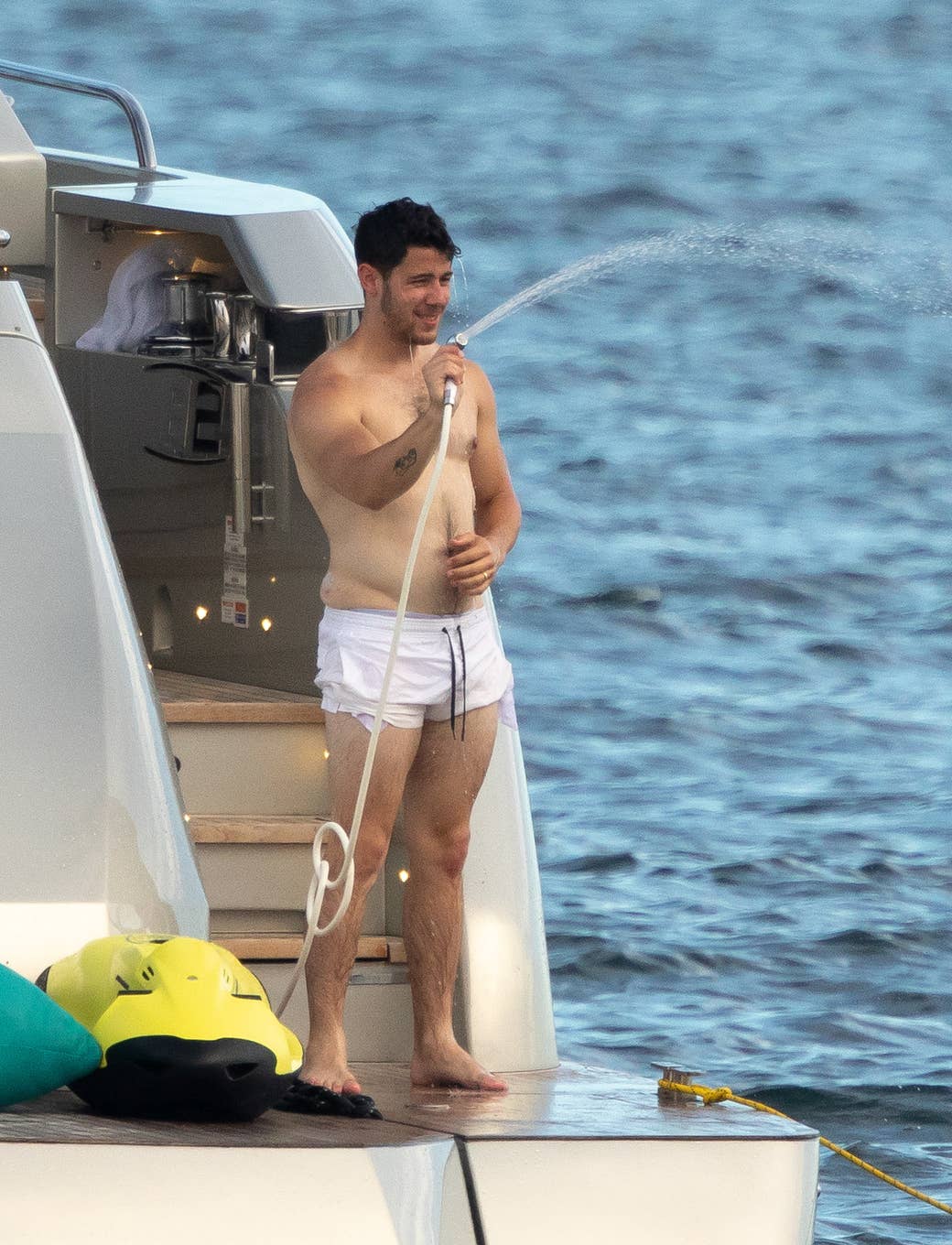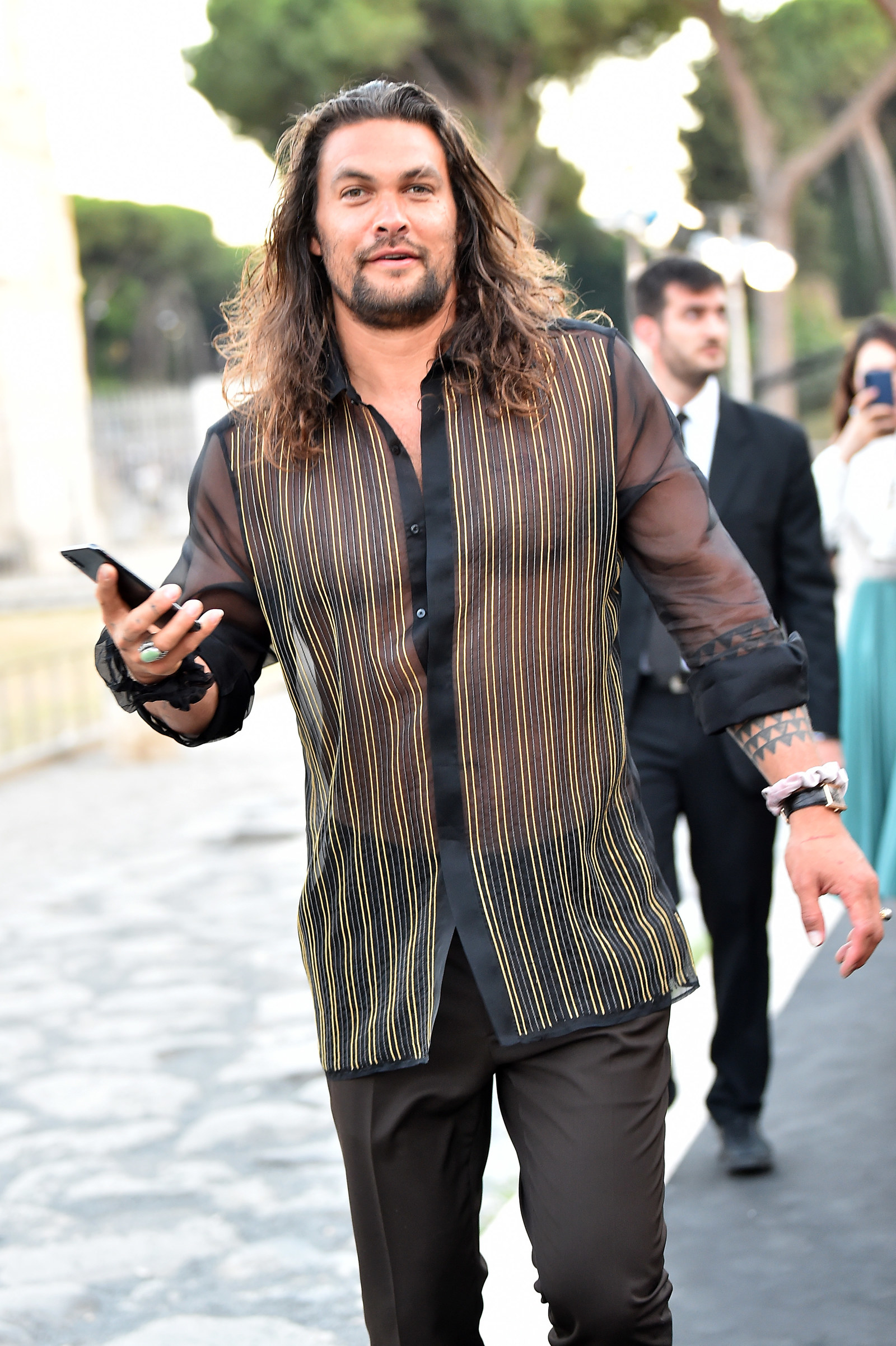
It's summertime: the season for barbecues, heading to the beach with friends, paparazzi shots of celebs frolicking on yachts in exotic locales, and, uh, male body-shaming?
Earlier this month, something of a social media brouhaha erupted over paparazzi pics of famously buff Aquaman star Jason Momoa relaxing on vacation. In the pictures, published by the Daily Mail, the lusciously maned thespian walks on a beach in the criminally long bermuda shorts that American men call swim trunks.
While the tabloids were quick to describe him as “musclebound,” some juvenile, trollish comments left on US Weekly’s Instagram account — "Looking a little soft. Still a hottie tho"; "Dad bod AF"; "Y'all forgot to photoshop some abs on him or what" — were spun into an apparent body-shaming controversy.
This week, new pics of pop star Nick Jonas, relaxing on a boat, also inspired headlines and thirst tweets about his so-called dadbod. The reaction to the pictures — at least on certain sections of Gay Twitter — were largely positive: “He looks Daddy af to me.” “nick jonas blow my back out challenge.” “I prefer @nickjonas like this.” “Nick Jonas is now so thick 😍... I'm here for it.” “nick jonas is halfway to dad bod and I’ve never been more attracted to him.” Getting in on the fun, Comedy Central tweeted Nick pics with the caption “Thicc Jonas is having a hot girl summer.” And then of course there was even lovingly made fan art of Thicc Jonas.
This dadbod debate has generated some thinkpieces about the way body image for straight men has now become subject to the same pressures and commercial forces that have long plagued women. It has even prompted a mini reckoning with the new standards — that some of the same magazines running the thinkpieces have promoted — of buffness for men. Yet Momoa and Jonas, regardless of slight variations in their muscular builds, obviously fit into our culture’s most idealized notions of masculinity.
What’s elided in the discourse that’s supposedly defending Momoa and Jonas as dadbod-hot, or that celebrates Jonas as thicc, is actual body positivity that combats fatphobia. Words like “thicc” were created by black women and queer men of color to challenge the kind of conventional standards of desirability that celebrities like Jonas and Momoa represent. Defending their supposed dadbods is merely promoting mainstream standards of desirability under the guise of subversiveness, repackaging thirst for the same conventionally hot bodies with a supposedly new twist.
The explosion of “dadbod” chatter coincides with the rise of paparazzi pictures of male celebrities captured in candid, unofficial mode when they’re not in properly lighted and photoshopped in magazine shoots or superhero-franchise physical shape. Thus, from the beginning, the standard of perfection that “dadbod” is supposedly expanding from is inherently ridiculous, and there’s always been a kind of tongue-in-cheek tinge to its usage.
Earlier this year, for example, when paparazzi pics of Jude Law in a white Speedo prompted dadbod discourse, the Irish Times joked that it was proof that fortysomething men can still break the internet, “so long,” the writer joked, “as you are rich, tanned, conventionally attractive, famous, physically fit, experiencing a midcareer resurrection, and willing to wear underwear in public. Jude, on behalf of all of us, thank you.” (Another publication even got regular dads to pose in white Speedos in response.)
There is room for this humor, in part, because straight men’s bodies — especially those that are celebrated as emblems of conventional hypermasculinity in the way that Momoa is — are not surveilled nearly as closely as women’s bodies are. “Dadbod” doesn’t even necessarily mean something bad. The “looking a little soft” taunt directed at Momoa is only negative if one finds softness — a feminized quality — inherently negative. But dadbod positivity is not really about embracing feminine qualities in men. It speaks to the increasing rise of the “hard” bodybuilding aesthetic as a kind of standard — though it’s one that is likely performed more for other men than women, since surveys have often shown that women aren’t particularly into that “hard body” type.

“Dadness” is not culturally imprinted onto men’s bodies in the way that motherhood is for women. While some might joke about husbands gaining sympathy weight with their pregnant wives, that isn’t really what “dadbod” connotes. There is actually no women’s equivalent to the “dadbod” phenomenon. If anything, coverage of celebrity motherhood has been less about expanding standards of desirability and more about highlighting pregnant women in inconceivably incredible shape, like Demi Moore’s 1991 Vanity Fair cover, or poking fun at pregnant women for gaining too much weight, like Kim Kardashian West as a floral couch. Then, of course, there are all the celebrities lauded for quickly regaining their so-called prebaby bodies.
The dadbod celebration, on the other hand, is in some ways linked to the aspects of gay male cultures that eroticize older men’s bodies and celebrate daddies. (This doesn’t mean there isn’t ageism in the gay community, but age and authority are eroticized in a different way among gay men.) Daddiness is also of a piece with the more accommodating standards given to older guys in straight culture; unlike with women, culturally we associate sexy attributes to men as they age, as implied in the term silver foxes.
Of course, dadness and “dadbods” aren’t just about age. Terms like daddy (in gay culture), or “zaddy,” which grew out of black vernacular, have to do with a certain kind of attitude: a butchness, authority, or swagger that certain men possess, which brings us — perhaps improbably for some — to Nick Jonas.
More so than Jason Momoa, Nick Jonas has acquired his “daddyness” in public and in relation to (white) male gayness. Jonas has famously baited his adoring gay audience with sexy underwear shoots. He’s been a big proponent of thirst traps, and he has played out his evolution from a twinkish pop star into a famously buff man through his Instagram posts. His recent marriage (at a relatively young age) to the older Priyanka Chopra adds to his Jersey suburban dad butch appeal. (Maybe that’s just me.)
Gay men have especially fraught relationships to mainstream standards of masculinity, and internalized homophobia and desire can collide in complicated ways. This is one of the reasons why body dysmorphia and striving for the idealized muscular, masculine body is so prevalent in the gay male community.
It’s not an accident that Jonas and his supposed “dadbod” now speaks to gay conflicts about internalized masculine norms, desire, and identification: for instance, the question of do gay men want to be him or have sex with him. Plenty of people have tweeted against the preposterous claim, made by some, that Jonas is not in conventionally muscled shape, and pointed, instead, to the way the celebration of his muscled body simply elides the actual fatphobia rampant in gay dating apps. This is all complicated by the way mainstream representations of whiteness and masculinity intertwine to marginalize the desirability of queer men of color.
In the paparazzi pictures that sparked this recent “dadbod” moment, Jonas smiles and points a hose at the ocean with playfully phallic glee. His short swim trunks are raised up, exhibiting his hunky thighs. He’s hairy and built. (Not incidentally, in almost all the reaction tweets, whether he’s being asked to blow someone’s back out or to spray them, he’s always positioned as the phallic top.)
Part of what the Nick Jonas discourse really reveals is the way queer thirst language has infiltrated the mainstream. In a recent BuzzFeed interview, Jonas read thirst tweets out loud, and it quickly became clear that thirst cultures now have a decidedly S&M flavor. "Nick Jonas could choke me on any holy day," he read, before adding, "Into choking, huh? Makes two of us." Yet instead of being used as a tool to move away from the white-dominated and masc-centric standards that permeate straight white media — and Instagram — this thirst language is now being used to recenter straight guys like Nick Jonas.
In a 2018 piece, Phillip Henry wrote about the way the word “thicc” was reappropriated by white Instagays to describe their own bodies. That process once again highlighted the cycle through which terms that were originally created by marginalized subjects to expand categories of desirability quickly get co-opted to recenter the very standards that such words are meant to displace. (Similarly, the whole concept of “hot girl summer,” started by Megan Thee Stallion, was quickly hijacked by beauty companies and white girls.)
We can celebrate Jonas — goddess knows I do — but calling him thicc participates in erasing the actual bodies that the term is meant to celebrate. I’m pretty sure he’d be okay with us sticking with “Daddy.” ●
